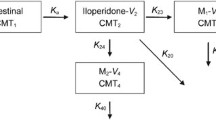Abstract
Rationale. Several antipsychotic drugs are metabolised by the polymorphic cytochrome P 450 CYP2D6. The impact of the polymorphism on the plasma levels and the occurrence of side effects have not been clearly established.
Objective. To investigate the impact of the CYP2D6 polymorphism on the steady-state plasma concentrations of zuclopenthixol and the occurrence of extrapyramidal side effects (EPS) and tardive dyskinesia (TD) during treatment with zuclopenthixol-decanoate.
Methods. Fifty-two clinically stable schizophrenic outpatients on monotherapy with zuclopenthixol-decanoate (100–400 mg/4 weeks) were genotyped for the CYP2D6 variants CYP2D6*3 and CYP2D6*4. Steady-state plasma levels of zuclopenthixol were analysed using high-performance liquid chromatography. Assessments of EPS, TD and psychopathology were performed twice with an 8-week interval using the extrapyramidal symptoms rating scale, the abnormal involuntary movement scale and the brief psychiatric rating scale.
Results. Thirty-five patients were homozygous extensive metabolisers (EMs), 13 were heterozygous EMs and 4 were poor metabolisers (PMs). While there were no significant genotype-related differences in the doses of zuclopenthixol decanoate, PMs as well as heterozygous EMs had significantly higher steady-state plasma levels of zuclopenthixol than homozygous EMs (median 9.5 nmol/l; 8.2 nmol/l and 5.9 nmol/l, respectively, P<0.05). The median dose-corrected plasma concentrations were 0.029, 0.038 and 0.048 nmol·l–1·mg–1 in homozygous EMs, heterozygous EMs and PMs, respectively, with statistically significant differences between homozygous EMs and heterozygous EMs (P=0.014) and homozygous EMs and PMs (P=0.03). Patients with neurological side effects were significantly older than patients without (P=0.02 in case of parkinsonism and P=0.04 in case of TD). Mutant CYP2D6*3 and *4 alleles tended to occur more frequently in patients with neurological side effects. An odds ratio (OR) of 2.3 (95% confidence interval 0.7–6.9) for development of parkinsonism and an OR of 1.7 (95% confidence interval 0.5–4.9) for TD was calculated in an individual with at least one mutated allele. However, the ORs were not statistically significant.
Conclusions. The higher zuclopenthixol steady-state plasma concentrations in heterozygous EM and PM schizophrenic patients receiving monotherapy with zuclopenthixol-decanoate than in homozygous EMs indicates a significant role of CYP2D6 in the systemic elimination of zuclopenthixol. The tendencies for patients carrying at least one mutated CYP2D6 gene to have an increased risk of parkinsonism and TD are in accordance with previous studies. Age was a significant risk factor for neurological side effects.
Similar content being viewed by others
Author information
Authors and Affiliations
Additional information
Electronic Publication
Rights and permissions
About this article
Cite this article
Jaanson, P., Marandi, T., Kiivet, RA. et al. Maintenance therapy with zuclopenthixol decanoate: associations between plasma concentrations, neurological side effects and CYP2D6 genotype. Psychopharmacology 162, 67–73 (2002). https://doi.org/10.1007/s00213-002-1059-5
Received:
Accepted:
Published:
Issue Date:
DOI: https://doi.org/10.1007/s00213-002-1059-5




